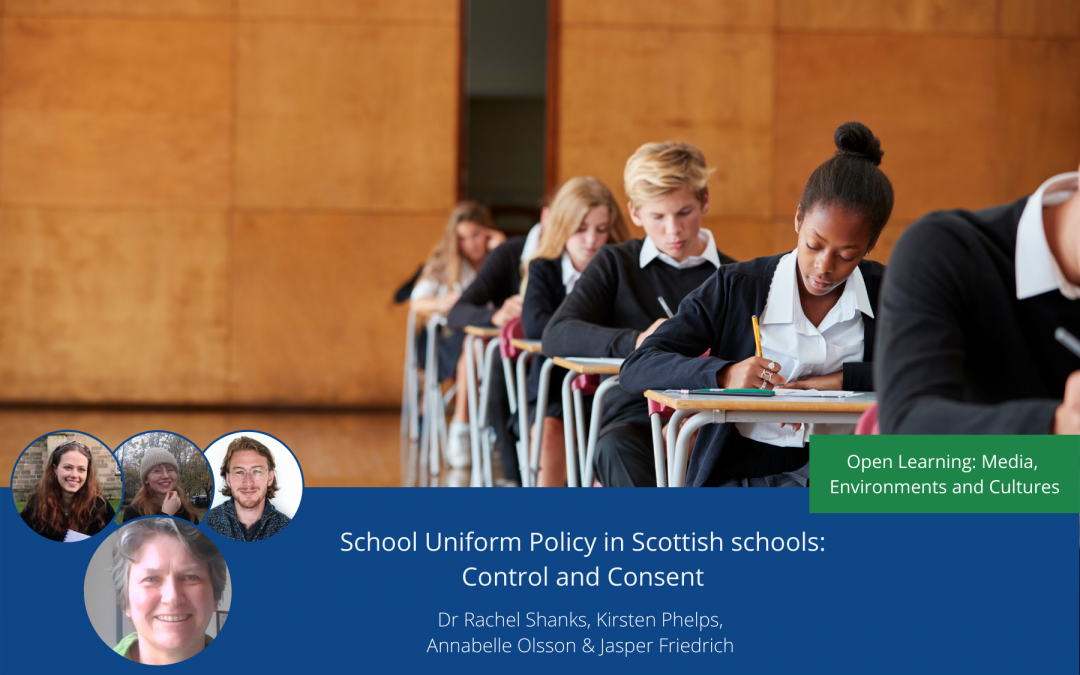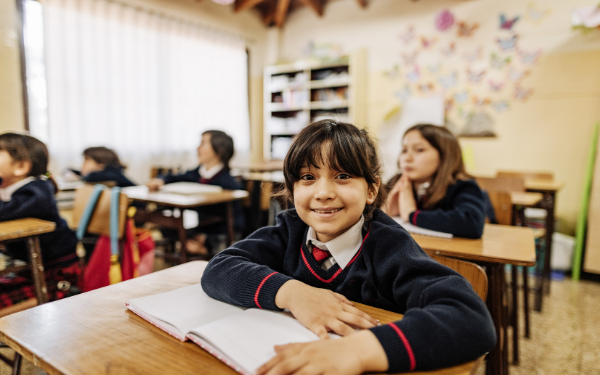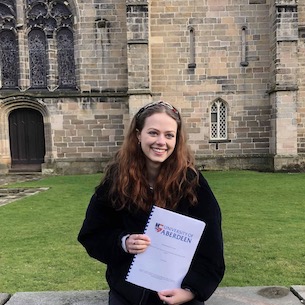
School Uniform Policy in Scottish schools: Control and Consent
A topic that is of continued interest to educational researchers – but also to teachers, pupils, and their parents – is school uniforms. As you may know, there is a marked difference between what pupils wear in school in the UK (England, Scotland, Wales and Northern Ireland), Ireland and the rest of Europe (recently Malta changed from formal uniforms to tracksuits). We set out to look into the reasons that schools give for having school uniforms.
I conducted the research with thirteen students from across the University of Aberdeen. A week-long course was designed to teach the qualitative data analysis software NVivo while taking part in an authentic research project. This was to provide undergraduates both research skills and experience.
I chose to analyse secondary school uniform policies because the policies are publicly available on school websites and do not involve confidential or sensitive information. We began our work with the identification of school uniform policies, school handbooks, and other information related to uniforms on each school’s website. After uploading the files, we read and coded the materials where we saw the reasons that were given for having a school uniform. Over the week, I benefited from over 300 hours of research assistance while the students learnt NVivo and applied this learning in the project.
Key Findings

Together we identified the different reasons that schools gave for requiring a school uniform. These included:
- ethos, identity, pride, sense of belonging
- safety, security/reduce truancy
- preventing competition/discrimination
- discipline and reduce bullying
- employability
- the reputation of the school
- financial benefits
- attitude to learning/improving standards of work
Students noticed more areas of interest, including the formality of the compulsory uniform from informal (no blazer or tie), mixed (blazer or tie) to formal (blazer and tie).
Of the 357 publicly funded secondary schools in Scotland we discovered:
- 343 schools (96%) require a uniform and just 14 schools do not
- 320 schools mandate the wearing of a school tie by both girls and boys
- 235 schools require a blazer to be worn
- 200 schools ban jeans
Three students have continued to analyse the data in areas of interest they identified, and we are close to submitting journal manuscripts. The students have also been involved in teaching doctoral students and university staff how to analyse qualitative research data using NVivo.
I asked the students to provide a summary of the analysis conducted so far and some of the questions or issues that arose from the research.
Uniform Policies & Gender – by Kirsten Phelps

Our analysis of school uniform policies regarding gender found that there were generally more rules and prescriptive policies for girls. Many policies mentioned the length of girls’ skirts using language that centred on the idea of decency or modesty. This suggests a placing of normative categories on girls and young women using school uniform policies, with those that follow the rules seen as moral/good and those who break them immoral/bad. Most schools in Scotland include ties as a mandatory part of their uniform for both boys and girls. This is notable as ties are not something usually worn in the workplace, or otherwise by women, yet they remain an entrenched part of the British school uniform.
School uniforms and employability discourse – by Annabelle Olsson

One specific justification for the uniform, employability, was analysed through the lens of governmentality. ‘Employability’ (Fotiadou, 2020; Moreau and Leathwood, 2006) is a concept referring to the ‘human capital’ – i.e., the skills, knowledge, and personal attributes – that makes an individual more likely to gain employment. Such discourses of employability generally overlook structural causes of unemployment, instead of placing the responsibility on the individual to continuously develop their skills and adapt to a precarious and competitive job market. In the policy documents, we discovered a rationale for the uniform based on such discourses. Fifty-three schools (15%) made linkages between the uniform and the world of work, illustrating a semi-hidden curriculum that implies that pupils should be presentable and employment-ready, conforming to the market and the workplace as well as their subordinate role within it.
Power and control in schools– by Jasper Friedrich

There appeared to be a tension between the practice of enforcing strict uniform policies and the way these practices are justified. While almost all policies include highly detailed regulations (some go as far as specifying the minimum length of girls’ skirts) and strict enforcement measures, justifications tend to focus on ‘soft’ values such as creating a sense of belonging and giving pupils self-confidence. We found it useful to analyse this in terms of Michel Foucault’s theorisation of different historical modes of power . When school uniforms were first introduced in the early modern period, they were what Foucault terms a technique of disciplinary power: one that ‘compares, differentiates, hierarchizes, homogenizes, excludes’. We still very much see this in how the policies homogenize dress while differentiating between girls and boys, creating hierarchies (prefects often wear special uniforms) and excluding those who do not conform.
In contrast, the justifications for these strict uniform policies are often cast in terms of what Foucault would call ‘governmentality’, a type of power that seeks to manage people with their consent instead of controlling them. The emphasis here is on how students will feel more included and improve their ‘human capital’ as a result of wearing uniforms – the uniform is justified not as a convenient tool of administration and control, but rather as a valuable part of the ‘product’ schools can offer parents.
Next Steps

Further analysis of the data set includes looking at the affordability of school uniforms, to what extent religious/philosophical beliefs are taken into account in the policies, and what is in place for pupils who identify as non-binary or who are in the process of transitioning gender. I hope to conduct research in schools that have involved pupils in decisions around uniforms.
I also hope to collaborate with researchers in other countries on school uniforms, dress codes, and appearance policies, so please get in touch if this interests you.
Finally, this project showed how it is possible to combine the teaching of qualitative data analysis software such as NVivo with actual data analysis providing a win-win for the academic and the students involved.
References and Further Reading
(2020) Denaturalising the discourse of competition in the graduate job market and the notion of employability: a corpus-based study of UK university websites, Critical Discourse Studies, 17:3, 260-291, DOI: 10.1080/17405904.2018.1546606
(2006) Graduates’ employment and the discourse of employability: a critical analysis, Journal of Education and Work, 19:4, 305-324, DOI: 10.1080/13639080600867083
The Power Thinker – Why Foucault’s work on power is more important than ever
School sends pupils home for wearing unpolishable shoes, no blazer and old footwear – Metro UK
Affordability of secondary school uniform in Scotland – University of Aberdeen (PDF).
Authors

Dr Rachel Shanks
Senior lecturer in the School of Education at the University of Aberdeen in Scotland
Dr Rachel Shanks is a senior lecturer in the School of Education at the University of Aberdeen in Scotland. She sits on the Executive Committee of the Scottish Educational Research Association (SERA) and is the link person with the Educational Studies Association of Ireland (ESAI). She is a co-convenor of EERA Network 6: Open Learning: Media, Environments and Cultures. Rachel is the Programme Director of the BA in Professional Development at the University of Aberdeen and regularly runs workshops on how to use NVivo. Her research interests fall into three main categories: professional learning and mentoring; digital technologies in education; and school uniform/dress code policies. Rachel is also a member of the British Educational Research Association (BERA) and is currently conducting research funded by BERA on teacher preparation and new teachers’ responses to teaching during the COVID-19 pandemic.

Kirsten Phelps
Graduate Student, St Andrews University
Kirsten is a graduate student studying Middle East, Caucasus, and Central Asian Security at St Andrews University. Her interests include social movements and post-conflict transitions.

Annabelle Olsson
Graduate Student, University College London
Annabelle is a graduate student in Health Humanities at UCL. Her interests include emancipatory education and student wellbeing, social and anthropological perspectives on mental health, and interdisciplinary research methods.

Jasper Friedrich
Graduate Student, University of Oxford
Jasper Friedrich is a graduate student at the Department of Politics and International Relations at the University of Oxford. He is interested in social and political theory, especially critical approaches and theories of power.
